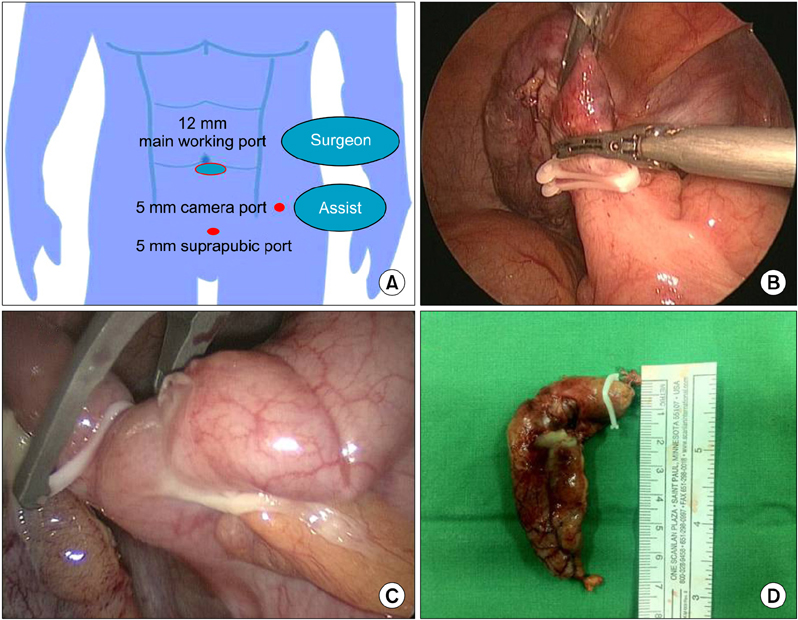J Korean Surg Soc.
2013 Jan;84(1):27-32.
The usefulness and safety of Hem-o-lok clips for the closure of appendicular stump during laparoscopic appendectomy
- Affiliations
-
- 1Department of Surgery, Inje University Haeundae Paik Hopsital, Inje University College of Medicine, Busan, Korea. d002045@paik.ac.kr
Abstract
- PURPOSE
The purpose of this study was to investigate the safety and usefulness of the Hem-o-lok clip for the closure of appendicular stumps and limitations of the Hem-o-lok clip.
METHODS
From May 2010 to August 2011, 105 consecutive patients underwent laparoscopic appendectomies by three surgeons. XL size Hem-o-lok clips were used for the closure of appendicular stumps by one surgeon. The remaining surgeons used double endoloop ligatures. Prospectively collected data from patients who underwent laparoscopic appendectomy due to acute appendicitis were retrospectively reviewed.
RESULTS
A total of 105 laparoscopic appendectomies were performed. The endoloop group consisted of 66 patients (mean age, 34.6 years; range, 16 to 82 years), while the Hem-o-lok group consisted of 39 patients (mean age, 43.5 years; range, 11 to 88 years). In three cases, the Hem-o-lok clip was not used due to enlargement and severe inflammation of the appendix base. No specific intraoperative or postoperative complications were observed in either group.
CONCLUSION
The use of Hem-o-lok clips for the closure of appendicular stumps in laparoscopic appendectomy is a feasible, safe, fast and cost-effective procedure in patients with a mildly to moderately inflamed appendix base of less than 10 mm in diameter.
MeSH Terms
Figure
Reference
-
1. Semm K. Endoscopic appendectomy. Endoscopy. 1983. 15:59–64.2. Arcovedo R, Barrera H, Reyes HS. Securing the appendiceal stump with the Gea extracorporeal sliding knot during laparoscopic appendectomy is safe and economical. Surg Endosc. 2007. 21:1764–1767.3. Kim HO, Yoo CH, Lee SR, Son BH, Park YL, Shin JH, et al. Pain after laparoscopic appendectomy: a comparison of transumbilical single-port and conventional laparoscopic surgery. J Korean Surg Soc. 2012. 82:172–178.4. Pedersen AG, Petersen OB, Wara P, Ronning H, Qvist N, Laurberg S. Randomized clinical trial of laparoscopic versus open appendicectomy. Br J Surg. 2001. 88:200–205.5. Kazemier G, in't Hof KH, Saad S, Bonjer HJ, Sauerland S. Securing the appendiceal stump in laparoscopic appendectomy: evidence for routine stapling? Surg Endosc. 2006. 20:1473–1476.6. Delibegovic S, Matovic E. Hem-o-lok plastic clips in securing of the base of the appendix during laparoscopic appendectomy. Surg Endosc. 2009. 23:2851–2854.7. Hanssen A, Plotnikov S, Dubois R. Laparoscopic appendectomy using a polymeric clip to close the appendicular stump. JSLS. 2007. 11:59–62.8. Partecke LI, Kessler W, von Bernstorff W, Diedrich S, Heidecke CD, Patrzyk M. Laparoscopic appendectomy using a single polymeric clip to close the appendicular stump. Langenbecks Arch Surg. 2010. 395:1077–1082.9. Delibegovic S. The use of a single Hem-o-lok clip in securing the base of the appendix during laparoscopic appendectomy. J Laparoendosc Adv Surg Tech A. 2012. 22:85–87.10. Wagner M, Aronsky D, Tschudi J, Metzger A, Klaiber C. Laparoscopic stapler appendectomy: a prospective study of 267 consecutive cases. Surg Endosc. 1996. 10:895–899.11. Partecke LI, von Bernstorff W, Karrasch A, Cziupka K, Glitsch A, Stier A, et al. Unexpected findings on laparoscopy for suspected acute appendicitis: a pro for laparoscopic appendectomy as the standard procedure for acute appendicitis. Langenbecks Arch Surg. 2010. 395:1069–1076.12. Tobias-Machado M, Forseto P Jr, Medina JA, Watanabe M, Juliano RV, Wroclawski ER. Laparoscopic radical prostatectomy by extraperitoneal access with duplication of the open technique. Int Braz J Urol. 2004. 30:221–226.13. Bomfim AC, Andreoni C, Miotto A, Araujo MB, Ortiz V, de Figueiredo LF, et al. The "boatman's knot": a new option for renal hilum ligation during laparoscopic nephrectomy. Acta Cir Bras. 2005. 20:258–261.14. Schick KS, Huttl TP, Fertmann JM, Hornung HM, Jauch KW, Hoffmann JN. A critical analysis of laparoscopic appendectomy: how experience with 1,400 appendectomies allowed innovative treatment to become standard in a university hospital. World J Surg. 2008. 32:1406–1413.15. Rickert A, Bonninghoff R, Post S, Walz M, Runkel N, Kienle P. Appendix stump closure with titanium clips in laparoscopic appendectomy. Langenbecks Arch Surg. 2012. 397:327–331.16. Delibegovic S, Iljazovic E, Katica M, Koluh A. Tissue reaction to absorbable endoloop, nonabsorbable titanium staples, and polymer Hem-o-lok clip after laparoscopic appendectomy. JSLS. 2011. 15:70–76.
- Full Text Links
- Actions
-
Cited
- CITED
-
- Close
- Share
- Similar articles
-
- Study on the Feasibility and the Safety of Hem-o-lok Clipping for Complicated Acute Appendicitis during Laparoscopic Appendectomy
- Floating Hem-o-Lok Clips in the Bladder without Stone Formation after Robot-Assisted Laparoscopic Radical Prostatectomy
- Abdominal Pain Due to Hem-o-lok Clip Migration after Laparoscopic Cholecystectomy
- A Feasible Technique for Transient Vascular Occlusion by Using a Vessel Loop and Hem-o-Lok Clips in Laparoscopic Partial Nephrectomy
- Comparison of Endo-GIA Stapler and Hem-o-lok Clip for the Vascular Control during Laparoscopic Nephrectomy



